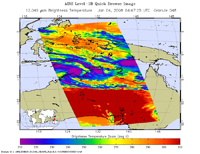NOAA and Indianapolis Motor Speedway Address Potential Race Day Weather Hazards

Just in time for the 2008 Indianapolis 500, officials from National Oceanic Atmospheric Administration's Indianapolis National Weather Service office and Indianapolis Motor Speedway have improved awareness, planning and communications for protecting race fans from severe weather.
Earlier this week, National Weather Service central region director Lynn Maximuk presented speedway officials with a certificate recognizing the race venue as a StormReady® Supporter.
"StormReady® encourages communities and businesses to take a proactive approach to improving local hazardous weather operations and public awareness," said Dave Tucek, warning coordination meteorologist at NOAA's Indianapolis weather forecast office.
"StormReady® arms participants with improved communication and safety skills needed to protect lives and property. Indianapolis Motor Speedway officials have done an outstanding job in developing the necessary infrastructure to meet the criteria set forth by the StormReady® program."
Speedway personnel worked with Tucek and other local Weather Service personnel to meet the guidelines necessary to earn NOAA's StormReady® Supporter recognition. To earn StormReady® designation, Speedway officials addressed:
- Establishing a 24-hour warning point and emergency operations;
- Redundant ways to receive weather forecasts and warnings and to alert race fans;
- Creating an internal system to monitor local weather conditions;
- Promoting the importance of public readiness through seminars;
- Developing a formal hazardous weather plan for training severe weather spotters and holding emergency exercises.

The National Oceanic and Atmospheric Administration, an agency of the U.S. Commerce Department, is dedicated to enhancing economic security and national safety through the prediction and research of weather and climate-related events and information service delivery for transportation, and by providing environmental stewardship of our nation's coastal and marine resources. Through the emerging Global Earth Observation System of Systems (GEOSS), NOAA is working with its federal partners, more than 70 countries and the European Commission to develop a global monitoring network that is as integrated as the planet it observes, predicts and protects.
 Deep Sea Crabs
Deep Sea Crabs